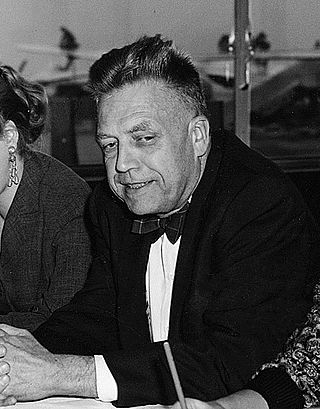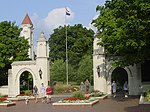
The Kinsey Reports are two scholarly books on human sexual behavior, Sexual Behavior in the Human Male (1948) and Sexual Behavior in the Human Female (1953), written by Alfred Kinsey, Wardell Pomeroy, Clyde Martin, and Paul Gebhard and published by W.B. Saunders. Kinsey was a zoologist at Indiana University and the founder of the Kinsey Institute for Research in Sex, Gender, and Reproduction.

Sexology is the scientific study of human sexuality, including human sexual interests, behaviors, and functions. The term sexology does not generally refer to the non-scientific study of sexuality, such as social criticism.

Alfred Charles Kinsey was an American sexologist, biologist, and professor of entomology and zoology who, in 1947, founded the Institute for Sex Research at Indiana University, now known as the Kinsey Institute for Research in Sex, Gender, and Reproduction. He is best known for writing Sexual Behavior in the Human Male (1948) and Sexual Behavior in the Human Female (1953), also known as the Kinsey Reports, as well as for the Kinsey scale. Kinsey's research on human sexuality, foundational to the field of sexology, provoked controversy in the 1940s and 1950s, and has continued to provoke controversy decades after his death. His work has influenced social and cultural values in the United States as well as internationally.

The Kinsey scale, also called the Heterosexual–Homosexual Rating Scale, is used in research to describe a person's sexual orientation based on one's experience or response at a given time. The scale typically ranges from 0, meaning exclusively heterosexual, to a 6, meaning exclusively homosexual. In both the male and female volumes of the Kinsey Reports, an additional grade, listed as "X", indicated "no socio-sexual contacts or reactions" (asexuality). The reports were first published in Sexual Behavior in the Human Male (1948) by Alfred Kinsey, Wardell Pomeroy, and others, and were also prominent in the complementary work Sexual Behavior in the Human Female (1953).
A nocturnal emission, also known as a wet dream, sex dream, nightfall, or sleep orgasm, is a spontaneous orgasm during sleep that includes ejaculation for a male, or vaginal lubrication and/or an orgasm for a female.
Development of sexuality is a part of the development and maturation of children. It includes a range of sensory, emotional, and consequent sexual activities that may occur before or during early puberty, but before full sexual maturity is established. The development of child sexuality and the perception of child sexuality by adults is influenced by social and cultural aspects. The concept of child sexuality also played an important role in psychoanalysis.

Paul Henry Gebhard. Jr. was an American anthropologist and sexologist. Born in Rocky Ford, Colorado, he earned a BS and a PhD from Harvard in 1940 and 1947, respectively. Between the years 1946 and 1956, Gebhard was a close colleague to sex researcher Alfred Kinsey. It was acknowledged in Gebhard's New York Times obituary that Kinsey was in fact his mentor and that Gebhard was fascinated when Kinsey first met him and revealed to him that the men's room at Grand Central Terminal in New York City was a frequent site for gay cruising.
Wardell Baxter Pomeroy was an American sexologist. He was a frequent co-author with Alfred C. Kinsey.

Kinsey is a 2004 American biographical drama film written and directed by Bill Condon. It describes the life of Alfred Charles Kinsey, a pioneer in the area of sexology. His 1948 publication, Sexual Behavior in the Human Male was one of the first recorded works that tried to scientifically address and investigate sexual behavior in humans. The film also stars Laura Linney, Chris O'Donnell, Peter Sarsgaard, Timothy Hutton, John Lithgow, Tim Curry, and Oliver Platt.

Erwin J. Haeberle was a German social scientist and sexologist.
Dr Julia R. Heiman is an American sexologist and psychologist. The sixth Director of The Kinsey Institute for Research in Sex, Gender, and Reproduction at Indiana University, she began on June 1, 2004. Dr. Heiman is also a professor in the Psychology Department at Indiana University with a joint appointment in the Psychiatry Department at the IU School of Medicine in Indianapolis.
John H. Gagnon was a pioneering sociologist of human sexuality who wrote and edited 15 books and over 100 articles. He collaborated with William Simon to develop the piece he is perhaps best recognized for: "Sexual Conduct: The Social Sources of Human Sexuality" (1973). He was Distinguished Emeritus Professor of Sociology at the State University of New York at Stony Brook, where he taught and from 1968 to 1998. In that same time frame, he also dedicated himself to advancing the field of sociology through his research.

Debby Herbenick is an American author, research scientist, sex educator, sex advice columnist, children's book author, blogger, television personality, professor, and human sexuality expert in the media. Herbenick is a professor at the Indiana University School of Public Health (IUSPH) and lead investigator of the National Survey of Sexual Health and Behavior (NSSHB), which Time called "the most comprehensive survey of its kind in nearly two decades."
Leonore Tiefer is an American educator, researcher, therapist, and activist specializing in sexuality, and is a public critic of disease mongering as it applies to sexual life and problems.

Sex Offenders: An Analysis of Types is a 1965 book about sex offenders by the anthropologist Paul Gebhard, the sociologist John Gagnon, the sexologist Wardell Pomeroy, and Cornelia Christenson. It was a publication of the Institute for Sex Research.
June Machover Reinisch is an American psychologist who has helped advance the public's general knowledge of human sexual activity. From 1982 to 1993, she was director of the Kinsey Institute at Indiana University. Her research at the Institute focused on sexual and psychosexual development. She has published more than 100 scientific papers in such journals as Science, Nature, JAMA, American Psychologist, Hormones and Behavior, MMWR, JPSP, Archives of Internal Medicine, and the British and American Journals or Psychiatry.
Fred Harrison Cate is the vice president for research at Indiana University and distinguished professor and the C. Ben Dutton Professor of Law at Indiana University Maurer School of Law. He is a senior fellow of the Center for Applied Cybersecurity Research. Cate specializes in information privacy and security law issues. He has testified before numerous congressional committees and speaks frequently before professional, industry, and government groups.
This is a timeline of asexual history worldwide. The briefness of this timeline can be attributed to the fact that acceptance of asexuality as a sexual orientation and field of scientific research is still relatively new.














